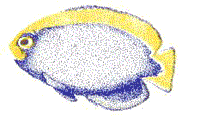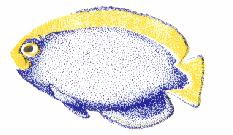|
Scyphozoan Class, Jellyfish
The most commonly referred to Jellyfish belongs
to the class of Scyphozoan. They are disc shaped animals that are seen
floating near, or beached, the shore. Jellyfish are one of the most beautiful
and awe inspiring creatures of the ocean, certainly one of the most popular
attractions at public aquariums.
Within the class of Scyphozoan are the orders
of Semaeostomeae, which contains 50 described species of mainly coastal
water jellyfish, including the popular Aurelia and Chrysaora. The order
Coronatae include 30 described species of deep sea jellyfish. The order
Rhizostomeae contains 80 described species, which include the Cassiopea
jellyfish, seen often in petshops, who swim upside down as they contain,
and expose, their photosynthetic symbiotic algae to sunlight. The order
Stauromedusae consists of 30 described species, which are the non swimming
stalked jellies that are generally found in cooler waters. They are vase shaped
and fixed by a basal stalk. Their mouth is pointed upwards
Jellyfish, or Sea Jellies, are made up of 99%
water, and are found all over the world and in all the seas, even in some
freshwater locations. A jellyfish's body is made up of two layers, and
in between is a jellylike substance, which is how they get their
name. Their bodies range in size from 1 to 16 inches, with a few species
attaining up to 6 feet across and 15 feet in length.
Most Jellyfish have very short lifespans and may
live for only a few weeks, or at the most a
couple of years and feed on small plankton type animals
that they capture within their tentacles, which have stinging cells, called
nematocysts.
The life cycle of Scyphozoan jellyfish consists
of three stages ; Adult jellyfish sexually produce eggs and sperm
and the larvae is, either 'brooded' within the gut of the adult or
develops as a free swimming planula. The planula settles onto a substrate, the hydratuba
stage, and develops into an adult, or scyphistoma. The scyphistoma, which is a sessile or stationary
polyp, asexually buds off a small medusa, called an Ephyra, which develops into an adult.
Midwater Systems has
developed a custom acrylic
jellyfish tank, called the Jelliquarium, and is working on holding systems used to keep
these midwater collections and gelatinous organisms in
suspension. Click here for information on the

or
browse the links below for more information on..... |













